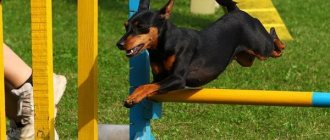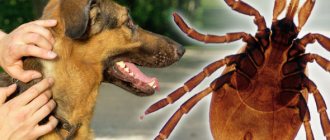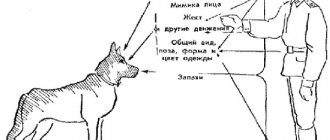To train or not to train – that is the question
A trained dog is the key to the owner’s peace of mind
Today, dog training has become one of the ways owners communicate with their pets. It is well known that four-legged animals express their thoughts and feelings in a non-human way, often succumbing to animal instincts. To prevent this from turning into pogrom at home, giving the cat a heart attack and punishing the dog, you should think about training that will help the pet control itself.
There are several positive aspects to dog training:
- from the very beginning of life, the puppy will be able to become a full-fledged part of the family;
- it is possible to nip the dog’s bad behavior in the bud;
- You can teach your pet the necessary skills: help around the house, etc.;
- guests will be stunned by the dog’s obedience and calmness; you won’t have to lock the dog up so that it doesn’t harm strangers;
- be it a Russet Terrier, a Labrador, or even a mongrel, he will become your closest ally and faithful comrade.
Important! Lack of training can cause the dog’s character to become bitter and display aggression on its part. She may begin to sabotage and stop obeying.
Training and its main methods
Doctor of Biological Sciences L.V. Krushinsky in his book “Study on the phenogenetics of behavioral traits in dogs” identifies four main methods of training dogs:
- A mechanical method, the essence of which is to reinforce orders with physical stimuli. This can be either pressing, jerking or hitting, or stroking. The stimulus will help the pet remember the command at the level of reflexes. For example: the instructor pulls the leash, the dog opens its mouth, after which a stick is inserted there. If a shepherd or other breed of dog wants to get rid of an object, the person lightly hits the lower part of the jaw. This is how the reflex is preserved.
- Taste-encouraging method. It is one of the key methods of professional instructors. To reinforce the conditioned stimulus (gesture), the trainer uses a food stimulus—a tasty reward. The method has both pros and cons. The pet begins to trust its trainer, but with a feeling of satiety, it may stop following commands.
- Contrast method. It is the one that dog trainers use most often. This is a combination of the two previous methods. The mechanical method becomes a stimulating method, while the taste-rewarding one helps to consolidate the reflex.
- Imitative method. Used to train your pet’s reaction to the “voice” command. It is used less rarely compared to previous options, but it also has a place.
It is important for each dog to find its own special method and approach.
Please note! The mechanical method is considered the most dangerous, since if used persistently it can make the dog overly irritable.
The contrast method is considered one of the most common and successful for training dogs.
Retrieving method of training.
The method found application relatively recently with the advent and spread of such training systems as IPO. As a stimulus, the object of prey is used - the fetching object, as well as objects to which the fetching behavior is transferred; As a reward, the same object is used, which is given to the dog (or the dog is allowed to take it in its teeth). such training systems as recently as recently with the emergence and spread of weak
Positive aspects of the method:
exceptionally high activity and interest of the dog in work is achieved; many special skills can only be developed using this method; low load on the animal’s nervous system. Negative aspects: the method is ineffective for dogs with insufficiently developed fetch behavior; if the approach to training is not correct, the dog, being overly interested in fetching, may, under certain circumstances, give preference to fetching rather than your commands (someone is playing with a stick to the side, and the dog runs there in frustration)
Imitative method of training dogs.
The dog's desire for imitative, flocking, collective actions is used as motivating stimuli. It is usually used in combination with any of the above methods. For example, when developing the skill of jumping a barrier, many dogs willingly follow a well-trained dog. It is also used in developing defensive skills.
Positive aspects of the method:
low load on the nervous system; rapid development of conditioned initial reflexes. Negative aspects of the method: not effective enough for all dogs; the method is not suitable for improving the conditioned reflex into a skill. With this method, it is possible to develop only some conditioned reflexes. I do not recommend using this method for working on an obedience course with chaleric dogs.
Train yourself or contact a dog trainer
It is worth understanding that training dogs is a painstaking and long process. Not everyone can cope with this task, which is why they decide to turn to the services of dog handlers. Training a fighting breed puppy or a pet with a difficult character can be a pain. This is where dog trainers will come to the rescue.
For the convenience of the owner and pet, depending on financial capabilities and time, there are several types of activities:
- classical training, which takes place individually, takes about half an hour;
- group lesson - training in a group with dogs of different breeds: from husky to spitz, will contribute to the socialization of the pet and will help you learn to respond adequately to distractions;
- training followed by foster care with a dog handler, during which the pet lives for a long time with the trainer - about a month, since the owner does not have time to exercise with the dog.
A dog trainer will help teach your pet basic commands within the required period of time.
Important! Despite the fact that a dog handler will teach the pet commands, the presence of the owner is also required. This will help the dog not lose contact with the owner.
Training courses
There are special courses that vary depending on the place of residence, the nature of the pet, and the list of necessary skills to learn:
- OKD (general training course). In classes of this kind, the dog is taught basic commands, classes are available to all breeds - from Chihuahua to Labrador.
- UGS (controlled city dog). This type of training is suitable for those who are wondering how to train dogs for urban conditions. Trainers will help a novice dog breeder teach his pet to react correctly to an abundance of traffic, obey the owner, etc.
- ZKS (protective guard service) is more suitable for fighting breeds of dogs, such as the German shepherd. Here, instructors train dogs for territory protection, guard duty and service in military units. You can start training only when the puppy is one year old.
- Service and rescue, after which the dog becomes a professional rescuer and is ready to serve faithfully to all people.
Professionals in their field will figure out how to train a dog and will be able to help you cope with instilling key skills in your pet.
How to properly allocate time and effort to training a dog
Training a toy terrier at home
Proper timing is an important rule for successfully training a dog. Here are the main aspects that you should pay attention to when allocating time and effort:
- Classes should be short. Five to seven minutes will be enough for the puppy. An adult dog can exercise most effectively within ten to fifteen minutes.
- Regularity is the key to success. The result will not be long in coming, but only with regular training. You shouldn't skip classes, especially in the first couples.
- Repetition is the mother of learning. In addition to learning new material, you need to periodically recall and consolidate already learned skills.
Classes should be short
The training can be divided into three blocks of five to ten minutes, depending on the age and individual characteristics of each animal. It is recommended to take a short break between blocks, during which the dog plays a simple game with the owner.
Methods and rules for teaching dogs commands on their own
Training dogs yourself at home from scratch is becoming the choice of many owners who want to establish contact with their pet and teach him basic commands. It is right to start training from a young age, since at this stage of life the dog easily perceives information, is open and its habits are easier to change.
Adequate distribution of time and effort for training
The sensitivity of dogs is developed especially in the first year and a half of life, before he becomes an adult. The owner must understand that the first six months is twenty percent of the workload, from six months to a year is fifty percent, and the remaining six months until the age of 1.5 years is thirty percent of the work. Subsequently, the dog breeder only occasionally trains the pet so that it is active and remembers commands.
How to prepare and get started
Once the owner has decided to start training, it is important to prepare before training the dog at home or on the street.
What you need to prepare:
- the right collar, possibly with a tape measure;
- tasty reward for training;
- comfortable clothes for the owner;
- a pre-prepared list of commands on paper or on the phone;
- good mood;
- adequately allocated time.
Important! There is no need to feed the dog before training so that he is ready to work productively. Otherwise, he may not take instructions seriously.
Once everything is prepared, you need to find a place where no one will disturb the owner and pet, everything is safe. After this, you can start training.
How often to conduct classes
Owners who are wondering how to train a dog should conduct classes on a regular basis - daily. 15-20 minutes a day is enough to get started. Gradually the load can be increased.
Each lesson brings the owner and pet closer to the goal
It is important to understand that you need to allocate a little more time, since unforeseen circumstances may delay your arrival home. If the timing has not been calculated adequately, it may irritate the owner, the dog will begin to make mistakes, and contact between the pet and the dog handler will be lost.
When to start training your puppy
A puppy's brain reaches its maximum development by the age of five months. Therefore, it is important to lay down the basic commands before this point. Therefore, it is worth starting training with a small pet immediately after purchase. If the puppy has reached the age of 3-4 weeks, you can teach him the basics of training.
Important! Training at the first stage should be in the form of a game. Screaming and hitting a small pet is not advisable unless it is necessary.
Dog training methods. Skill development
First method
- mechanical training. To obtain the desired unconditioned reflex, the trainer uses a mechanical stimulus (coercion). To get your dog to sit, you can follow the command “Sit!” with strong hand pressure on the croup. Showing a protective reflex, the dog will sit. Repeating this technique will develop a conditioned reflex in the animal to the command, and the dog will sit down at the order of the trainer.
Mechanical stimuli used in dog training include: hand pressure on various parts of the body, forcibly giving the body the desired position, jerking with a leash, jerking with a strict collar, hitting with a whip.
Second method -
taste training. Food is used as an unconditioned stimulus. The landing reflex is induced by lifting a piece of meat above the dog's head. If such an influence is combined with the command “Sit!” and is accompanied by the giving of treats, then on the basis of the food unconditioned reflex the dog also forms a conditioned reflex. In the future, she will sit down only on the orders of the trainer.
The actions that, during the training process, the dog learns to perform based on the trainer's signals are more complex than ordinary conditioned reflexes (for example, the conditioned salivation reflex). Special studies have shown that these actions are complex motor reactions of the dog, consisting of a system of reflexes. Such complex actions of a dog are usually called a skill. A skill is an individually acquired combination of unconditioned and conditioned reflexes.
When developing skills, the most appropriate is a contrasting method of training, which consists in combining mechanical and taste-rewarding methods. When practicing a skill, it is necessary, in addition to the unconditioned stimulus (food or mechanical), to use another stimulus. The unconditioned stimulus has the same meaning as in the development of a conditioned reflex, that is, it is a reinforcing stimulus. The impact of the second stimulus should cause a certain motor reaction. Thus, this stimulus will be motivating (pushing) to perform the desired action. This reaction is combined with a conditioned signal from the trainer (command, gesture, etc.).
Analysis of the formation of skills shows that in these cases, two conditioned reflexes are formed, closely related to each other: firstly, a food reflex is established in response to a certain motor reaction of the dog, and this reaction, as a conditioned stimulus, begins to cause a food reflex (the dog sits down to in order to get food); secondly, a conditioned motor reaction (skill) is formed to perform a given action on a signal. The pushing stimulus, originally used to evoke a motor response, becomes redundant as soon as the dog begins to exhibit this action at the command of the trainer.
For example, in order to teach a dog to sit on the command “Sit!” Based on the contrast training method, it is necessary to first use two stimuli (mechanical and food).
A mechanical stimulus (pressing a hand on the croup) causes a sitting position (a protective-defensive reflex in a passive form), and food is the main unconditioned stimulus that reinforces the execution of the action through the use of the food unconditioned reflex. The command “Sit!” must be combined with exposure to both stimuli. It either precedes their action, or is supplied simultaneously with the use of a mechanical stimulus. After the command “Sit!” the skill of landing is formed, the mechanical stimulus gradually loses its significance, and the performed action should be reinforced only with a food stimulus. On the command “Sit!” a conditioned reflex is formed.
When using the mechanical training method, the contrast value is also maintained. The contrast here is the two different positions of the dog. One position is associated with the impact of a mechanical painful stimulus (a blow to the croup with a whip, pressure on the sacrum with a hand, a jerk with a leash). The other (the position of the completed landing) relieves the dog from the effects of a painful stimulus. Here, to reinforce a certain position of the dog, the main thing is the absence of negative, painful, irritation. This example shows well how plastic the dog’s higher nervous activity is (adaptation to environmental influences). Every trainer must remember that when using mechanical (especially painful) stimuli, reinforcement is not the action of the stimulus itself, but getting rid of it. Therefore, during the training process, one should not abuse strong mechanical stimuli, which cause a general depression of nervous activity in animals, and in some even a passive defensive reaction.
A distinctive feature of the skill is that the animal takes a more active part in the manifestation of this action: performing this movement on its own if it is a means to satisfy a vital need (searching for food, pursuing and tracking prey) or avoiding an action that may be dangerous to the body . Many skills that are developed on the basis of predominant reactions and lead to the satisfaction of the dog’s vital needs appear much faster and become more durable than conditioned reflexes in laboratory experiments.
A yard dog that has once been beaten with a stick will always avoid a person with a stick in his hand.
An already trained dog can be used as a stimulating (pushing) stimulus when training dogs. To develop viciousness in young dogs, training can be done in the presence of a vicious adult dog. It is recommended that a young dog that needs to be trained to overcome obstacles be brought to an area where they are trained with a well-trained dog. Her jumping over an obstacle will serve as a motivating (pushing) stimulus for your dog. This method of training can be called imitative.
Training techniques
In each case, training using one method or another is carried out using techniques.
A technique is a system of influencing a dog in order to develop a certain skill.
Each training technique is divided into the following stages.
First stage
- education of the initial action (the main conditioned reflex) to a certain conditioned stimulus (sound command, gesture, etc.).
In the skill of a dog approaching a trainer on the command “Come to me!” The initial action is for the dog to approach the trainer without sitting at the left leg.
When practicing the skills “Stand!”, “Sit!” and “Lie down!” At first, the dog is required to carry out the command without restraint.
At this stage, the trainer must solve two problems: induce the dog to perform the desired action and develop an initial conditioned connection to the command.
The first stage is characterized by two features.
Firstly, the dog may experience the phenomenon of generalization of conditioned stimuli. The dog “does not yet know how” to clearly distinguish commands and may exhibit erroneous actions, for example, lie down on the command “Sit!” etc. The trainer must “slow down” the dog’s erroneous actions and reinforce only those performed correctly with treats.
Secondly, at this stage, a stable connection with the team has not yet been established; the trainer cannot yet overcome the influence of distracting stimuli. Therefore, when developing initial actions, classes should be conducted in an environment with the least amount of distracting stimuli.
Second stage -
complication of the initially developed action of a conditioned reflex into a skill. In this case, to the initial action learned from the dog, actions are added that complicate the initial conditioned reflex. For example, when a dog approaches the trainer on the command “Come to me!” such a complication is securing its specific position near the trainer’s left leg and establishing a conditioned reflex to the gesture, holding it in various positions, etc.
At the second stage of training, environmental conditions should not be complicated. This makes it quick and easy to develop the desired skills. It is necessary to ensure that the dog clearly distinguishes (differentiates) the commands used, and promptly “slow down” its erroneous actions. To do this, such actions are not reinforced with a treat, but those performed correctly are necessarily reinforced with encouragement.
Third stage
— consolidation of a complex action (skill) being practiced in various environmental conditions. As soon as the dog learns to carry out all the actions clearly and reliably, the environment in which the training takes place must be made more complex, the location of the training must be changed as often as possible so that the new environment is necessarily associated with the presence of extraneous stimuli (various sounds, the presence of people, animals, etc.). d.). At first, in such conditions, the dog will strongly manifest its orienting reflex, but gradually it will begin to fade, and the dog will get used to new stimuli. To control the dog’s behavior in difficult conditions, the trainer must gradually use stronger measures of influence (increase the strength of the mechanical stimuli used). In this case, it is necessary to give commands with a threatening intonation, as a conditioned signal for subsequent painful impact.
If the dog is distracted and refuses to perform a certain action, it is necessary to achieve the execution of the command, taking into account the appropriate method of influencing the dog in these conditions.
The techniques consist of different, but strictly defined influences.
Methods of training dogs to perform complex actions in communications, guard, search and other services are based on the fact that animals gradually learn complex actions. The whole process of working with a dog consists of implementing a number of techniques. Moreover, each subsequent technique can be used only if, with the help of previous techniques, the animal has developed skills on the basis of which a new result (a more complex skill) can be obtained.
When training guard dogs, it is necessary to develop their malice and distrust of people, accustom them to work on a short tight leash, etc.
Requirements for a trainer
During the training process, the main factor organizing the dog's behavior is the trainer. He not only influences the dog’s behavior, but also ensures that he performs actions that ensure his official use. The success of the work depends on the theoretical preparedness of the trainer and his practical experience. The trainer must correctly and quickly solve problems that arise during the training process, and remember the need for an individual approach to the dog. This is primarily due to an attentive attitude to work, and attention, as is known, is the basis of observation, without which it is impossible to study the behavior of an animal. To develop observation skills, the trainer must keep a diary in which he notes the results achieved and the characteristic features of the dog’s behavior, as well as mistakes made by the trainer himself. Analyzing these records will greatly facilitate further work with the dog.
The methods and techniques used in the training process must be applied differently in each case. Without this, an individual approach to a dog is unthinkable.
In order to skillfully control the dog’s actions, the trainer must be strictly consistent in his work. When starting to develop a particular skill in a dog, you first need to outline which method and technique should be used, and think carefully about the sequence of your actions. Once you start training your dog, you need to persistently complete the assigned tasks. Various changes and additions that arise during the training process must be strictly justified.
The training process must be built taking into account existing methodological principles. By remembering the correct actions and techniques, the trainer will firmly grasp the necessary technical skills.
When training, various difficulties often arise. The reasons that cause them may depend on the dog’s behavior or unexpected environmental influences. To quickly make the right decision, the trainer must have a good knowledge of the theoretical foundations, practical techniques of working with a dog and skillfully apply them.
During practical training, the trainer should strive to keep the dog “interested” in the work. To do this, it is necessary to take into account the general condition of the dog (health, the degree of its excitability, the presence of estrus, etc.), not to overtire it and to diversify training methods. The skillful use and combination of coercion, encouragement and prohibition is of great importance. Each trainer must have restraint, resourcefulness, courage and strictly follow the sequence of his actions. The success of training largely depends on the love for animals. Therefore, the best option is when the dog is trained by the owner.
Training rules
The trainer must strictly adhere to the following rules:
1) when starting training, you need to carefully study the characteristics of the dog’s behavior (type of higher nervous activity, predominant reaction), accustom the animal to yourself and only after that start working;
2) in each lesson it is necessary to set a specific task and achieve its implementation;
3) strictly observe the basic rule for developing a conditioned reflex: apply the conditioned stimulus (command, gesture) somewhat earlier than the unconditioned one, or, in extreme cases, simultaneously;
4) do not change commands, but use appropriate intonation and carefully monitor the correctness and clarity of commands and gestures;
5) do not be nervous, avoid rudeness and excessive affection, be demanding and persistent, not forgetting to encourage every correct action of the dog;
6) training should be carried out according to the principle: “from simple to complex”;
7) do not tire the dog with the monotony of exercises, diversify the activities, trying to maintain the dog’s interest in performing various actions;
 carefully monitor the physical condition of the animal.
carefully monitor the physical condition of the animal.
General obedience course for puppies
After understanding at what age to train a puppy, you can begin the initial stage of training. Initially, you should make it clear to the small pet that he is not a leader. This is the main goal for the first few weeks.
What you need to do for this:
- If there is disagreement, the puppy may try to bite the owner. This is where you need to raise your voice and let him know that this is unacceptable. For example: “Jack, you can’t!”, “Jack, stop!” and so on, accompanying the word with a slap. If he doesn’t stop, you need to hit him a little harder and say it even louder.
- If a small husky, terrier or other breed of dog is lying where it shouldn't, you need to loudly drive it away from there, accompanied by a small spank with a wet towel. It doesn't hurt, but it will feel unpleasant. Then you need to invite him to lie down in his place in a pleasant voice, after completing the command, stroke him and reward him with a treat.
- There is no need to feed your pet from the table.
- Instill the skill of calm response during examination. If the puppy behaves calmly, you need to reward it. If he doesn’t obey, you need to shake him slightly by the withers, and then continue the inspection.
- Command "Near!" will help the puppy to get ready and always be under control, not to break out when leaving the apartment and the entrance to the street. To do this, you need to pull the leash when trying to break free and speak the command loudly.
Additional Information! The owner's love and patience, coupled with adequate training, will help establish contact with the pet.
After a few weeks, the puppy will begin to get used to the commands.
Each time the puppy will begin to take commands more seriously and more attentively
General training course (GTC) independently
The secret of good interaction between the owner and the pet lies in teaching the general course of training from an early age. Therefore, it is important to take care of this in advance.
Attention! The general training course is designed to teach the pet the basic commands that it will need for adequate walks around the city and living in an apartment with its owner.
Necessary commands to control a dog in the city
It is important for all pets to learn the rules of behavior in the city, since a dog that does not know how to adequately respond to its owner’s commands is dangerous to others and itself, since it can commit actions that are dangerous to its life.
A trained dog will become a good companion if it is taught several basic commands:
- respond to your own nickname, encouraging your pet to respond and obey;
- command “Near!” is practiced in this way: you need to lead the dog on a short leash, allowing you to deviate from your leg, but with the command “Near!” pull to yourself, reward with a treat when done;
- at the command “Come to me!” you need to show the treat in your hand, but as soon as the pet comes running, you don’t need to fasten it, but give it the opportunity to run away, repeat several times and make sure that the skill is instilled;
- command “Sit!” is practiced in this way: a special word is said to the dog, after which the collar is pulled back and the owner presses the croup; if done correctly, a sweet reward;
- command "Ugh!" it is important to practice so that the dog avoids poisoning from eating an unfamiliar object for food or attacking a person, for this you need: sharply pull the leash towards you, say the command, repeat until it is learned.
In order for the dog to behave appropriately, every owner should think about teaching the basic rules of behavior in the city
What is included in the obedience course
OKD includes basic commands:
- Sit!
- Lie!
- To me!
- Near!
- Ugh!
The OKD can be passed at a special event, having received the appropriate mark in the animal’s documents. Dogs of all breeds are allowed to pass this certification.
Passing the OKD is required for dogs of all breeds
Useful tips from professional dog handlers
Malkov M., 25 years of experience as a dog handler: “You need to choose a pet based on your character, since if there is incompatibility, problems may arise that will lead to irritation of both the dog and the owner. When training a dog, there is no need to humanize it; it is important to stop permissiveness. You should try to instill in your pet the habit of going to the toilet outside, at least in middle or older age. Training a dog is an individual case each time; everyone needs their own special approach. Not a single manual or lesson in a training center can help if the owner does not love his pet, so love is the most important criterion in training.”
Spiridonov V., 20 years of experience as a dog handler: “It is necessary for the owner to train the dog, and not vice versa. It is important to start training your pet from the age of several weeks, since the basis is laid before six months, then the dog has a flexible memory, and it adequately perceives the owner’s commands. After six months, a hormonal surge occurs, which can increase the dog’s level of aggression if the necessary commands are not taught in time. The main thing in training and education is love for the pet, which will help eliminate all problems.”
The main ingredient of any training is the owner’s love for the pet.
Training a pet is an important part of the owner’s life, which will help eliminate possible problems in the bud. You need to start as early as possible, pay attention to training every day, and be properly encouraged. In this case, the owner will receive a well-trained and well-mannered dog.











